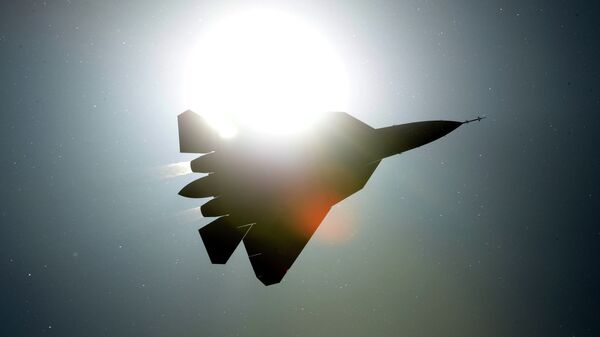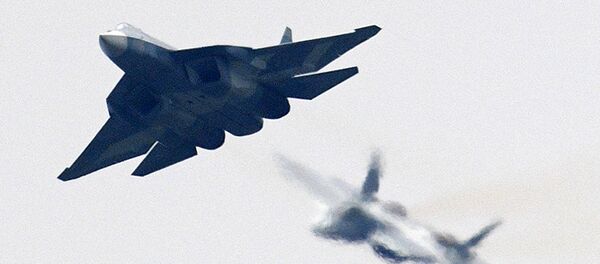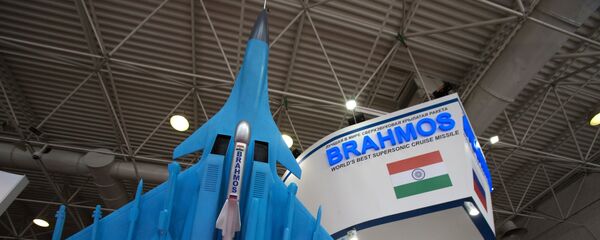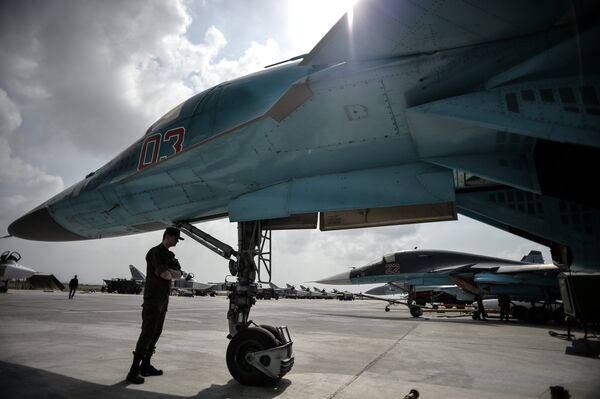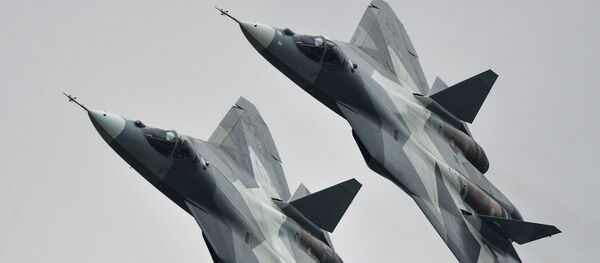Deployment Details
So far, both the Kremlin and the MoD have stayed mum on the subject of the Su-57s' possible mission to Syria. But a simple observation of Su-57-related news from recent months seems to indicate that the deployment is highly likely.
Vladimir Gutenov, Duma lawmaker in charge of a commission supporting the Russian defense industry, told Sputnik that while he could not independently confirm the Su-57s' deployment to Syria, he "whole-heartedly welcomed" the reports. According to the lawmaker, the planes "need to be tested in combat conditions, in conditions of [enemy] resistance." Furthermore, he said, the presence of the Su-57s will doubtlessly send a political message, serving as a deterrent "for aircraft from neighboring states which periodically fly into" the Middle Eastern country uninvited.
Exclusive#Russia deploying its brand new fifth generation fighter jet the Su-57 in #Khmemeim AB #Syria
— Wael Al Hussaini (@WaelAlHussaini) 21 февраля 2018 г.
2 Su-57
4 Su-35
4 Su-25
1 A-50U were deployed in the #RuAF AB in Latakia/Jableh today pic.twitter.com/MA4NIKyMW7
What Russian Experts Are Saying
Russian military experts have offered a myriad of possible reasons for the Su-57s' deployment to Syria.
For instance, Andrei Frolov, editor-in-chief of Arms Export, a Russian military publication, told RBC that the deployment would help to advertise the planes, especially to the Indian market, in light of the joint Russian-Indian Sukhoi/HAL Fifth Generation Fighter Aircraft (FGFA) program.
For one thing, he said, "Lockheed Martin is active on the Indian market. Furthermore, there are difficulties with India on the FGFA project. The public launch of the Su-57 last year and its deployment to Syria now is aimed at convincing the Indians that the FGFA is a real project, which has a prototype that not only flies, but is capable of operating in a warzone."
Emphasizing that the Su-57 was an excellent tool which would "come in handy" in the event of any "provocations against our forces in Syria," Antoshkin also commented on rumors circulating online about the US Air Force allegedly suspending its F-22 Raptor flights over Syria due to the appearance of the Russian planes in the country.
For one thing, Antoshkin recalled, the Su-57 is equipped with 3D thrust vector jets, as opposed to the F-22's 2D thrust vector jets, meaning higher maneuverability for the Russian plane. "In addition, these engines allow our fighter to reach speeds up to Mach 2 without an afterburner. With its onboard Belka radar station, the Su-57 can detect 'stealth' aircraft, and track over 10 targets simultaneously. Add to this the plane's excellent radio-electronic warfare module, which suppresses enemy missiles' homing systems."
As far as onboard weapons are concerned, the observer recalled that "the Su-57 has two large internal weapons compartments, taking up practically the entire useful length of the aircraft. Each compartment can carry up to four K-77M air-to-air missiles," which have a range of nearly 200 km and serve as the rough equivalent to the US's AIM-120 Advanced Medium-Range Air-to-Air Missile.
Ultimately, Antoshkin stressed that while deploying just two planes is not enough to provide Russia with an overwhelming military advantage in the Syrian theater, it would cause Russia's potential adversaries to think twice: "I think it will give our geopolitical rivals an extra reason to ponder whether it is worth raising their hand against Russia," the veteran air force officer concluded.
Western Military Observers Respond
Wednesday's photo and video evidence of the Su-57 fifth-gen stealth fighters flying around Hmeymim certainly got the Pentagon's attention, with a DoD spokesperson complaining that the deployment was an indication that Russia was not living up to its "announced force drawdown."
Popular Mechanics was somewhat more evenhanded, pointing out that the deployment will give the Russian military an opportunity to "learn a lot about how the jet works in less-than-ideal conditions, how good its sensors are at picking up targets in the air and on the ground, and how difficult it is to maintain the planes thousands of miles from Mother Russia." However, that publication too offered its share of criticism, suggesting the Su-57s might stoke conflict with F-22s over US-controlled airspace in Syria, and would face the constant threat of mortar or drone attacks so long as they remain stationed in Hmeymim.
The National Interest's Dave Majumdar did one better, actually speaking to a Russian military expert – Vasily Kashin of the Moscow-based Center for Comprehensive & International Studies. According to Kashin, the Su-57s' deployment amounts to "testing in actual war," something that would help prepare the planes for mass production.
As for Majumdar, as far as the analyst can tell, the deployment will likely help the Russian military gain valuable operational experience and performance data on the Su-57's advanced avionics, including its active electronically scanned array radar and ELINT systems. Even "limited combat missions" are a possibility, he wrote.
